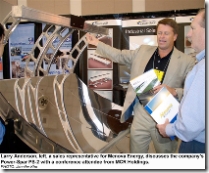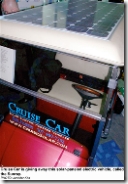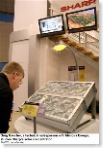At the Solar Power 2006 Conference & Expo in San Jose, the crowded exhibition hall was filled with rows and rows of all things solar. There were panels, concentrators, chargers, lights, and even a robot. And solar enthusiasts wandered through, engaging the exhibitors and exchanging ideas and business cards. The showroom closed Wednesday, but the conference continued Thursday, with “post conference” events Friday.
Solar panel maker Solon displays its solar tracking system, the Solon-mover, at the entrance to the San Jose McEnery Convention Center.
The company brags that the tracker is the “largest industrially manufactured ready-to-go” solar tracking system in the world, specially developed for large solar power stations and capable of supplying entire cities with solar energy. Solon claims it was the first German solar company to go public, in 1998.
Greg Gaucher, a technical salesperson with Menova Energy, studies Sharp’s solar concentrator. Concentrators use mirrors or lenses to magnify—or “concentrate”—sunlight onto smaller solar cells. Ron Kenedi, vice president of Sharp’s Solar Energy Solutions Group, says concentrators will take hold soon, becoming significant in three to five years (see Q&A: Sharp’s Ron Kenedi). Menova also makes solar concentrators.
 Larry Anderson, left, a sales representative for Menova Energy, discusses the company’s Power-Spar PS-2 with a conference attendee from MCR Holdings. The product is a “trough style” solar concentrator, which moves on two axes to track the sun. The absorber (the bar on top) can be switched out to provide solar electricity, solar heating, or direct lighting via fiber optics, said Nathalie Bastien, a Menova sales consultant based in San Jose.
Larry Anderson, left, a sales representative for Menova Energy, discusses the company’s Power-Spar PS-2 with a conference attendee from MCR Holdings. The product is a “trough style” solar concentrator, which moves on two axes to track the sun. The absorber (the bar on top) can be switched out to provide solar electricity, solar heating, or direct lighting via fiber optics, said Nathalie Bastien, a Menova sales consultant based in San Jose.
The aluminum concentrator is light and can be stamped together very rapidly, cutting manufacturing costs, she said. Ottawa, Canada-based Menova is just starting to expand into the U.S. market, and expects the Power-Spar 2 to deliver its clients a return on investment in only two to three years, she said. The company showcased a demonstration unit; the real ones are 40-feet long.
 Cruise Car is giving away this solar-paneled electric vehicle, called the Sunray. But don’t call it a golf cart. Technically, it’s only a golf cart if it goes less than 20 miles per hour, said Michael Margulis, a manufacturer representative based in Lakeport, California. This “low-speed vehicle” hits a top speed of 22 miles per hour—25 mph downhill, he jokes—and is street legal. It has a range of 65 miles, and can actually travel much farther if it’s in the sun, he says.
Cruise Car is giving away this solar-paneled electric vehicle, called the Sunray. But don’t call it a golf cart. Technically, it’s only a golf cart if it goes less than 20 miles per hour, said Michael Margulis, a manufacturer representative based in Lakeport, California. This “low-speed vehicle” hits a top speed of 22 miles per hour—25 mph downhill, he jokes—and is street legal. It has a range of 65 miles, and can actually travel much farther if it’s in the sun, he says.
The vehicle costs $7,000, before a $1,000 federal tax credit. The non-solar version, called the Classic Golf, costs $5,500 and has a range of 40 to 49 miles. In November, Cruise Car will come out with a speedier solar-paneled neighborhood electric car, the Solar Kudo, which will retail for $9,000, Mr. Margulis said.
A conference goer watches as a robot demonstrates picking up a solar panel and placing it on a frame. Normally, the robot, RV40, would trim the panel to match the size of the glass that would go on top. Reis Robotics originally built the robot for automotive applications, dye casting machines, laser cutting, and so on, said Julio De Souza, an Elgin, Illinois-based field service engineer for the German firm. Two years ago, Reis created a program to apply the robot to solar manufacturing, he said.
Source : Red Herring




Commentaires